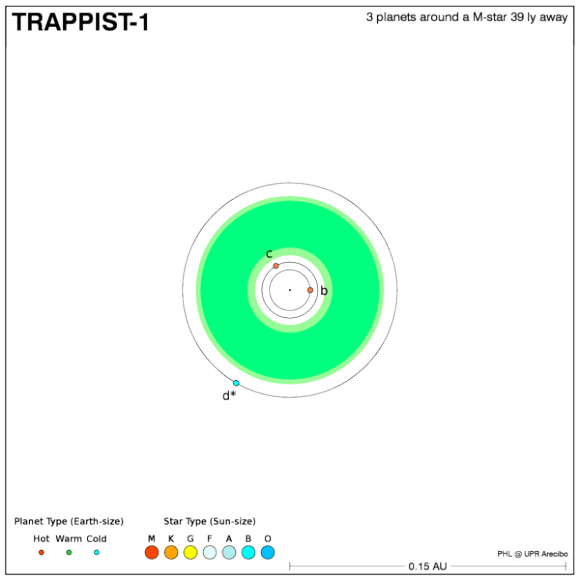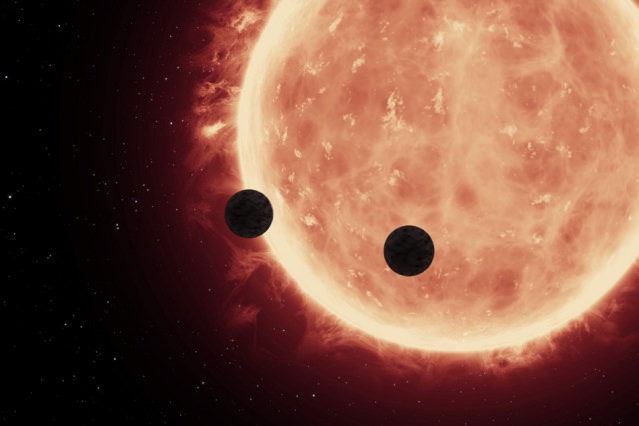When Hubble first observed the atmospheric conditions of an extrasolar planet in 2000, it opened up that entire field of study. Now, Hubble has conducted the first preliminary study of the atmospheres of Earth-sized, relatively nearby worlds and found “indications that increase the chances of habitability on two exoplanets,” say the researchers.
The planets, TRAPPIST-1b and TRAPPIST-1c, were discovered earlier this year and are approximately 40 light-years away. At the time of their discovery, it was unknown if the worlds were gas planets or rocky worlds, but Hubble’s most recent observations suggest that both planets have compact atmospheres, similar to those of rocky planets such as Earth, Venus, and Mars instead of thick, puffy atmospheres, similar to that of the gas planets like Jupiter.
“Now we can say that these planets are rocky. Now the question is, what kind of atmosphere do they have?” said Julien de Wit of the Massachusetts Institute of Technology, who led a team of scientists to observe the planets in near-infrared light using Hubble’s Wide Field Camera 3. “The plausible scenarios include something like Venus, with high, thick clouds and an atmosphere dominated by carbon dioxide, or an Earth-like atmosphere dominated by nitrogen and oxygen, or even something like Mars with a depleted atmosphere. The next step is to try to disentangle all these possible scenarios that exist for these terrestrial planets.”

The exoplanets were originally discovered by the TRAPPIST telescope at ESO’s La Silla observatory in Chile, which, like the Kepler telescope, looks for planetary transits (TRAPPIST stands for Transiting Planets and Planetesimals Small Telescope) observing dips in a star’s light from planets passing in front of it from Earth’s point of view.
The star, TRAPPIST-1, is an ultracool dwarf star and is very small and dim. TRAPPIST-1b completes an orbit around the star in just 1.5 days and TRAPPIST-1c in 2.4 days, and the planets are between 20 and 100 times closer to their star than the Earth is to the sun. Both are tidally locked, where one side of these worlds might be hellish and uninhabitable, but conditions might permit a limited region of habitability on the other side. And because of the star’s faintness, researchers think that TRAPPIST-1c may be within the star’s habitable zone, where moderate temperatures could allow for liquid water to pool.
“A rocky surface is a great start for a habitable planet, but any life on the TRAPPIST-1 planets is likely to have a much harder time than life on Earth,” said Joanna Barstow, an astrophysicist at University College London, who was not involved with the research. “Of course, our ideas of habitability are very narrow because we only have one planet to look at so far, and life might well surprise us by flourishing in what we think of as unlikely conditions.”
The researchers used spectroscopy to decode the light and reveal clues to the chemical makeup of the planets’ atmospheres. While the content of the atmospheres is unknown and are scheduled for more observations, the low concentration of hydrogen and helium has scientists excited about the implications.
The team realized a rare double transit was going to take place, when the two planets would almost simultaneously pass in front of their star, but they only knew two weeks in advance. They took a chance, and taking advantage of Hubble’s ability to do observations on short notice, they wrote up a proposal in a day.
“We thought, maybe we could see if people at Hubble would give us time to do this observation, so we wrote the proposal in less than 24 hours, sent it out, and it was reviewed immediately,” de Wit said. “Now for the first time we have spectroscopic observations of a double transit, which allows us to get insight on the atmosphere of both planets at the same time.”
Using Hubble, the team recorded a combined transmission spectrum of TRAPPIST-1b and c, meaning that as first one planet then the other crossed in front of the star, they were able to measure the changes in wavelength as the amount of starlight dipped with each transit.
“The data turned out to be pristine, absolutely perfect, and the observations were the best that we could have expected,” de Wit says. “The force was certainly with us.”
“These initial Hubble observations are a promising first step in learning more about these nearby worlds, whether they could be rocky like Earth, and whether they could sustain life,” says Geoff Yoder, acting associate administrator for NASA’s Science Mission Directorate in Washington. “This is an exciting time for NASA and exoplanet research.”


What is the age of Trappist-1b/1c compared to earth?
More than 500 Myrs. [ https://en.wikipedia.org/wiki/TRAPPIST-1 ] That was enough to have oceans and the first putative fossils here on Earth.
That age is a minimum limit you see often. It is put there when they can place the star on the main sequence for sure instead of being a not yet stabilized star. (If I understand correctly.) I am not sure why they don’t put up a maximum limit when they know that, since the star mass would imply its maximum age. but maybe the models are still too fuzzy for long-lived (relatively small) stars such as these.
Here Trappist-1 planets are in better shape than the recent K2-72 planets, who are so small that they are rocky for sure (it is believed), and are better centered on the surface habitability (possible ocean) zone. Unfortunately no one has dated K2-72,. so its planets may be too young to have life.